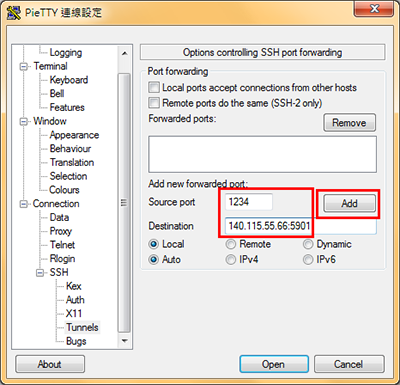
Whenever a connection is made to this port, the connection is forwarded over the secure channel, and the application protocol is then used to determine where to connect to from the remote machine. This works by allocating a socket to listen to port on the local side, optionally bound to the specified bind_address. Specifies a local "dynamic" application-level port forwarding. Anyone able to use $your_IP:$port_number as SOCKS server address will be seen by servers they visit as if they are at your computer. The above remark regarding firewall stands. You may want to establish key-based authentication so this ssh connection from localhost to localhost doesn't ask for your password. The command may be: ssh -g -f -N -D $port_number localhost

This is pointless when you use this SOCKS proxy with your local browser ( A= B= C) but if you allow connections from the outside then it makes perfect sense. There's no reason $hostname cannot be B's localhost it can. thus firewall doesn't interfere nor -g is necessary this can be done by ssh -L $some_port:localhost:$port_number $your_IP invoked at their side or ssh -R $some_port:localhost:$port_number $their_IP invoked at your side clients will use localhost:$some_port as SOCKS server address in their browsers. via their own separate ssh connection so their connections appear local (as if A= B) to your already running ssh -D.

Let's say you run the ssh command shown above and you tell your local browser to use SOCKS at localhost:$port_number. Obviously any case where A= C gives no direct advantage over simple A -> D connection, but there are other useful cases. Some of these letters may refer to same machine in some particular usage cases. D is any server, it sees communication from C and may not be aware that A and B are involved there may be many servers.C is the $hostname B connects to communication that normally goes to D from A now reaches D from C.B is the machine where ssh -D $port_number C runs and where the TCP $port_number listens for incoming connections from any A.A represents a single client that uses B:$port_number as SOCKS address there may be many clients.But with proxy this is as follows: A -> B -> C -> D In general the situation without SOCKS proxy provided by ssh is like this: A -> D Note you may not be allowed to open some ports as regular user, especially lower than 1024, use higher number then. This will open the $port_number TCP port on your local computer and establish a SOCKS server on it.

#BUILD SSH TUNNEL LINUX PASSWORD#
You need to provide credentials (like $username and password when asked) valid to the $hostname machine. The first command will use your current (local) username unless your ssh_config file tells otherwise (by default it doesn't). Or ssh -D $port_number $hostname identifies some machine it can be IP address, address resolvable via DNS or via /etc/hosts file or via ssh_config file etc.

Usage of ssh -D is indeed like this: ssh -D $port_number $hostname This syntax is not meant to be fully compatible with variables in any shell. Note: I use $ prefix for strings you have to substitute with your desired values.


 0 kommentar(er)
0 kommentar(er)
